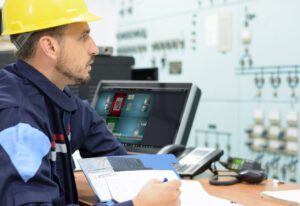This audio was created using Microsoft Azure Speech Services
Today’s energy demand continues to increase rapidly as a result of rising global population, economic growth and climate change. At the same time, 60% of global energy production is currently lost or wasted before it even reaches consumers. To meet the escalating demand, optimizing energy use is essential.
This ‘demand’ side of the energy equation is a critical—and often overlooked—component of how we can tackle the climate and energy crises, comprising over half (55%) of the potential for the decarbonization of energy between now and 2050.
Considering that energy accounts for over 80% of global carbon emissions, the key solution to tackle climate change is what we call Electricity 4.0—the combination of electrification and digitization. This helps us transition to cleaner energy and better optimize energy use, prioritizing the three sectors responsible for almost all (94%) energy-related emissions: buildings, industry and transport.
1. Modernize your buildings to be all-digital and all-electric
According to the World Green Building Council, buildings are responsible for almost 40% of all energy-related carbon emissions worldwide. Nearly three-quarters of these come from the energy that heats, cools and powers them…and this is, of course, compounded by changes to our climate. Digitalization and electrification are powerful ways to change that.
Retrofitting existing buildings is a huge part of the story. Think about it: 50% of the buildings that will exist in 2050 already exist today.
Installing low-energy solutions to improve energy efficiency and sustainability is a start. This can include energy-efficient lighting or high-quality insulation for example. But the real impact comes from being able to make real-time decisions to optimize temperature control and efficiency. This can be done using digital energy management tools like sensors that monitor not just temperature, but also humidity and light levels, as well as software that measures, analyzes and visualizes energy usage.
It’s imperative to optimize energy use of any new buildings, too—from their design and construction through to long-term lifecycle management.
We’re talking everything from construction materials to digital tools that analyze energy performance, smart charging stations that reduce energy consumption and analytics services that improve power reliability. Increasingly, organizations are also choosing to install microgrids to produce their own renewable or recoverable energy, such as solar panels or wind turbines, so they can reduce carbon footprint and also increase resiliency against external energy shortages and price hikes.
2. Explore decarbonization prospects within energy-intensive sectors
Industry is responsible for a quarter of all global emissions, according to the IEA—so we must make this an “electric decade” for industry, in which sites and whole supply chains can achieve accelerated decarbonization.
Compared to current processes, on-site electrification offers cleaner and smarter operations. A careful roadmap enables hard-to-abate industries to switch from fossil fuels to electricity-powered processes, cutting direct emissions and immediately delivering decarbonization impact while safeguarding operational integrity.
Electrification offers an opportunity to digitize. Advanced controls that enable data-based decision-making, combined with electrified infrastructure that is integrated with digital energy management software systems, empowers organizations to take steps to reduce scope 1 and 2 carbon emissions. For scope 3 emissions, a screening assessment targets sources with the biggest emissions.
Typically accounting for more than 80% of a company’s carbon footprint, scope 3 emissions must be a top priority for organizations. This requires working with partners across the supply chain, from sourcing raw materials, to manufacturing, logistics, storage and more. Companies should identify where sustainable materials can be used, reduce the use of carbon-intensive fuel sources and adopt renewable energy. If this isn’t possible, you may need to find alternative partners to ensure sufficient levels of decarbonization. Look for trusted partners who can help you on this journey.
3. Decarbonize the transport sector via infrastructure change
As the world’s population continues to grow, economies develop and urbanization continues accelerating, it’s critical that we electrify transport infrastructure where possible. Whether it be airports, railway, or shipping ports, digitization can bring about enhanced operational efficiencies, resilience and reduced downtime. Additionally, as the mass adoption of electrified personal and public transportation continues to grow, we need to massively expand the EV charging infrastructure worldwide while facilitating the decarbonization of other forms of transport like shipping, aviation, and freight. Wherever possible, electrification will enable more digital capabilities, driving efficiency and the ability to adapt to real-time customer needs.
We are already seeing, but need to accelerate (ideally solar-powered) electric chargers in parking lots to encourage employees, partners, and visitors to switch to electric vehicles. Microgrids can also play a big part by offsetting some of the pressure that additional electricity demand from EVs will have on grids. They can also bring energy autonomy in remote areas or places where grids are vulnerable to disruption from natural disasters or extreme weather.
And if an organization produces more energy than it needs, it can even store and sell the excess energy back to the main grid, when prices are at their highest, bringing potential for profit.
Increasing energy demand means our grids are more strained than ever. To best support the decarbonization of the transport sector, we need to adopt grids of the future now. This will allow for the integration of more renewables and distributed energy resources (DERs) to electrify transportation the right way. Digitally equipped, remotely managed and powered by data and integrated network models, grids of the future are more reliable, sustainable and secure.
The technologies exist today: Let’s use them!
A world in which everyone drives an ultra-efficient electric car and lives in an efficient, smart building might seem like something that’s far off in the future. But the tools to enable this are already available. If we start using them at greater scale and speed, we can better address the global climate and optimize energy use in a real, tangible way—right now.





Add a comment